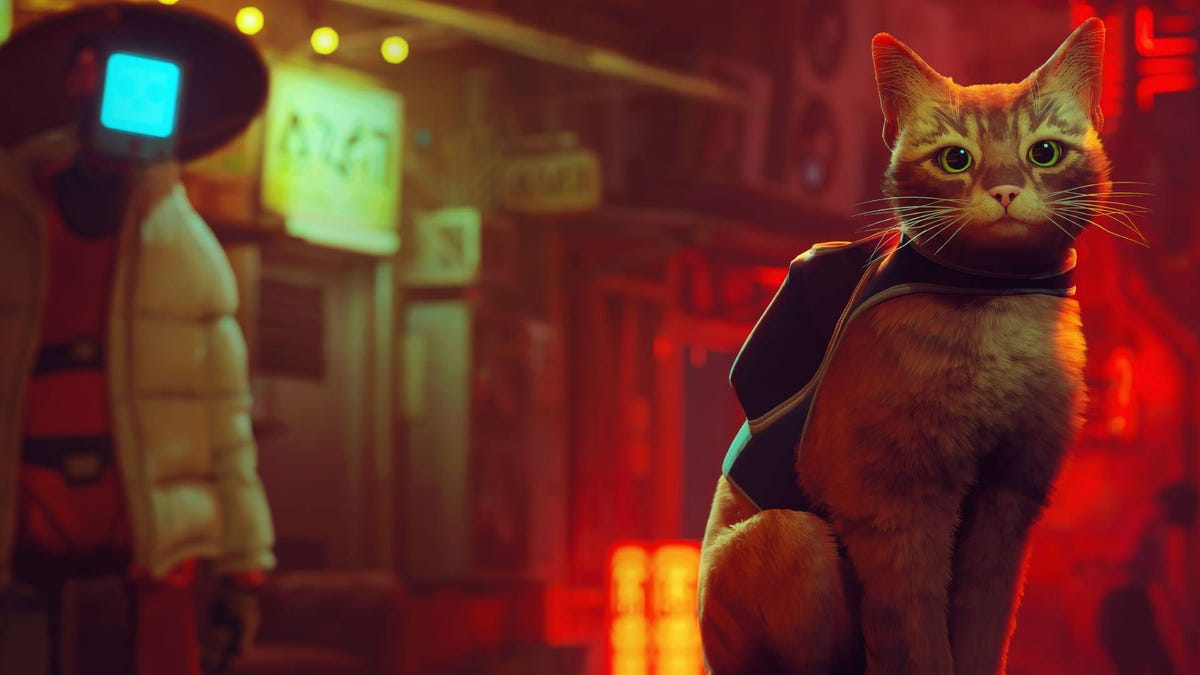Conical rice hats have a troubled history within the Asian diaspora community. They’re used as a racial shorthand to indicate Asian origins, regardless of the actual context. Clothing retailer Abercrombie and Fitch, for example, once used images of Chinese men in rice paddy hats in its product line. While the existence of farmer hats is not offensive by itself, it becomes astoundingly racist when used in unrelated imagery, such as a racist parody of a laundry business. Protests and angry letters forced Abercrombie and Fitch to pull the offensive t-shirts from their stores.
Thankfully, Stray meets the bare minimum of not racist language to describe the robots (even if its gratuitous use of the Japanese language in fictional Hong Kong is a bit eyebrow-raising). But the game’s rampant appropriation of Asian history and culture needs to be supported by care in design and implementation. Singapore-based Alexis Ong wrote an excellent Polygon article about Stray’s accuracy to Hong Kong, while others like Lam are less impressed by how the game portrayed the Walled City.
“The graffiti and signage is a huge question mark. Anything in English is clearly player facing but [in-game], who would those tags be for?” Lam told Kotaku. “It’s one thing if it’s robots passing messages to each other but some overlap each other instead of being written around each other. Which calls into question if said developers also understand graffiti culture and the etiquette. But also...Why deliberately make some robots wear rice hats? When there’s clearly no way to go outside or anywhere in game to farm?” Headwear such as baseball hats have become ubiquitous to urban fashion, which could explain the companions copying this style, but rice hats have not. These conical hats have been used to denote Asianness in western media, and Stray cannot separate itself from this history.
Since this comes up every time I write a blog about Asian representation: No, I don’t believe that BlueTwelve Studios is intentionally racist. Nor do I think that the resulting game is the worst offender when it comes to cultural appropriation. Its foibles are typical of the cyberpunk genre as a whole. Cyberpunk originates from America’s anxieties about Japan’s economic dominance, but cyberpunk media is often reluctant to populate their cities with Asian characters. I felt the same sense of alienation while I played Stray.
[WT Actual F ... ]

 kotaku.com
kotaku.com
I thought Oriental was
Thankfully, Stray meets the bare minimum of not racist language to describe the robots (even if its gratuitous use of the Japanese language in fictional Hong Kong is a bit eyebrow-raising). But the game’s rampant appropriation of Asian history and culture needs to be supported by care in design and implementation. Singapore-based Alexis Ong wrote an excellent Polygon article about Stray’s accuracy to Hong Kong, while others like Lam are less impressed by how the game portrayed the Walled City.
“The graffiti and signage is a huge question mark. Anything in English is clearly player facing but [in-game], who would those tags be for?” Lam told Kotaku. “It’s one thing if it’s robots passing messages to each other but some overlap each other instead of being written around each other. Which calls into question if said developers also understand graffiti culture and the etiquette. But also...Why deliberately make some robots wear rice hats? When there’s clearly no way to go outside or anywhere in game to farm?” Headwear such as baseball hats have become ubiquitous to urban fashion, which could explain the companions copying this style, but rice hats have not. These conical hats have been used to denote Asianness in western media, and Stray cannot separate itself from this history.
Since this comes up every time I write a blog about Asian representation: No, I don’t believe that BlueTwelve Studios is intentionally racist. Nor do I think that the resulting game is the worst offender when it comes to cultural appropriation. Its foibles are typical of the cyberpunk genre as a whole. Cyberpunk originates from America’s anxieties about Japan’s economic dominance, but cyberpunk media is often reluctant to populate their cities with Asian characters. I felt the same sense of alienation while I played Stray.
[WT Actual F ... ]

Stray Falls Into The Usual Orientalism Pitfalls Of The Cyberpunk Genre
The cat simulation game appropriates Asian aesthetics but doesn’t grapple with the Walled City’s historical legacy
 kotaku.com
kotaku.com
I thought Oriental was

Last edited:

